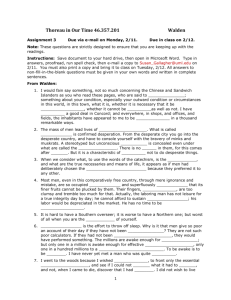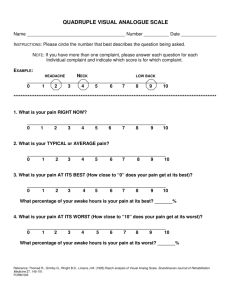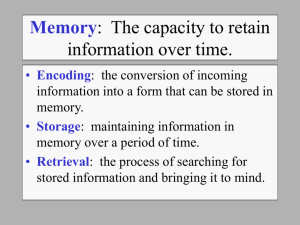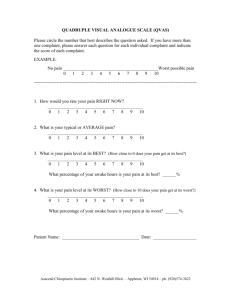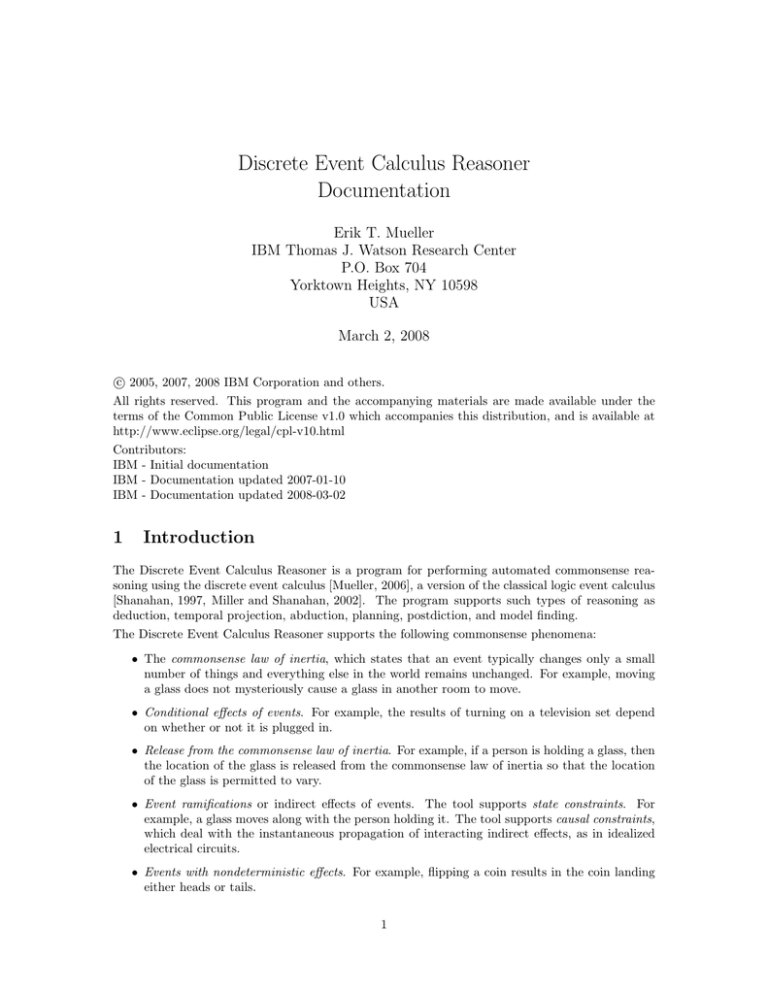
Discrete Event Calculus Reasoner
Documentation
Erik T. Mueller
IBM Thomas J. Watson Research Center
P.O. Box 704
Yorktown Heights, NY 10598
USA
March 2, 2008
c 2005, 2007, 2008 IBM Corporation and others.
All rights reserved. This program and the accompanying materials are made available under the
terms of the Common Public License v1.0 which accompanies this distribution, and is available at
http://www.eclipse.org/legal/cpl-v10.html
Contributors:
IBM - Initial documentation
IBM - Documentation updated 2007-01-10
IBM - Documentation updated 2008-03-02
1
Introduction
The Discrete Event Calculus Reasoner is a program for performing automated commonsense reasoning using the discrete event calculus [Mueller, 2006], a version of the classical logic event calculus
[Shanahan, 1997, Miller and Shanahan, 2002]. The program supports such types of reasoning as
deduction, temporal projection, abduction, planning, postdiction, and model finding.
The Discrete Event Calculus Reasoner supports the following commonsense phenomena:
• The commonsense law of inertia, which states that an event typically changes only a small
number of things and everything else in the world remains unchanged. For example, moving
a glass does not mysteriously cause a glass in another room to move.
• Conditional effects of events. For example, the results of turning on a television set depend
on whether or not it is plugged in.
• Release from the commonsense law of inertia. For example, if a person is holding a glass, then
the location of the glass is released from the commonsense law of inertia so that the location
of the glass is permitted to vary.
• Event ramifications or indirect effects of events. The tool supports state constraints. For
example, a glass moves along with the person holding it. The tool supports causal constraints,
which deal with the instantaneous propagation of interacting indirect effects, as in idealized
electrical circuits.
• Events with nondeterministic effects. For example, flipping a coin results in the coin landing
either heads or tails.
1
• Gradual change such as the changing height of a falling object or volume of a balloon in the
process of inflation.
• Triggered events or events that are triggered under certain conditions. For example, if water
is flowing from a faucet into a sink, then once the water reaches a certain level the water will
overflow.
• Concurrent events with cumulative or canceling effects. For example, if a shopping cart is
simultaneously pulled and pushed, then it will spin around.
Here is how you use the Discrete Event Calculus Reasoner. First, you place a domain description
into a file. (This file may load other files.) The domain description consists of
• an axiomatization describing a commonsense domain or domains of interest,
• observations of world properties at various times, and
• a narrative of known event occurrences.
The domain description is expressed using the Discrete Event Calculus Reasoner language. Then, you
invoke the Discrete Event Calculus Reasoner on the domain description. The program transforms
the domain description into a satisfiability (SAT) problem. (The SAT problem is expressed in the
standard format used by most SAT solvers [DIMACS, 1993].) The program then runs a SAT solver,
which produces zero or more solutions, called models. The program decodes these models and
displays them.
1.1
Software Requirements
The Discrete Event Calculus Reasoner runs under Windows and Linux. To run under Windows, you
will first need to install Cygwin, which is available from http://www.cygwin.com/. When installing
Cygwin, make sure you install Python, gcc, and g++. Most Linux installations already have Python,
gcc, and g++. (If you need to get Python, you can get it from http://www.python.org/. If you
need to get gcc and g++, you can get them from http://gcc.gnu.org/.) Under both Windows
and Linux, you will also need to download the following:
• One or more SAT solvers.
The following are recommended:
Relsat
[Bayardo Jr. and Schrag, 1997], which is available from http://www.bayardo.org/
resources.html, and Walksat [Selman et al., 1993], which is available from http:
//www.cs.rochester.edu/u/kautz/walksat/. Walksat can be used to display near miss
models (see Section 1.6). You can also use Minisat [Eén and Sörensson, 2004], which is available from http://www.cs.chalmers.se/Cs/Research/FormalMethods/MiniSat/Main.html.
• PLY (Python Lex-Yacc), which is available from http://www.dabeaz.com/ply/.
1.2
Installing the Program
Download the tar file decreasoner.tar.gz and issue the following command:
tar -zxvf decreasoner.tar.gz
Then continue by following the installation instructions in the file decreasoner/README.
To verify that the program is functioning properly, cd to the decreasoner directory and type the
following:
2
$ python
>>> import decreasoner
>>> decreasoner.test()
If the program is working properly, it will print something like the following:
loading examples/Shanahan1997/Yale.e
loading foundations/Root.e
loading foundations/EC.e
28 variables and 64 clauses
relsat solver
1 model
--model 1:
0
Alive().
Happens(Load(), 0).
1
+Loaded().
Happens(Sneeze(), 1).
2
Happens(Shoot(), 2).
3
-Alive().
-Loaded().
EC: 7 predicates, 0 functions, 0 fluents, 0 events, 0 axioms
Root: 0 predicates, 0 functions, 0 fluents, 0 events, 0 axioms
Yale: 0 predicates, 0 functions, 2 fluents, 3 events, 8 axioms
encoding 0.0s
solution 0.0s
total 0.1s
>>>
1.3
A Simple Example: Deduction
Here is a simple example of how to use the Discrete Event Calculus Reasoner. We use a text editor
to create a file containing the following domain description:
load foundations/Root.e
load foundations/EC.e
sort agent
fluent Awake(agent)
event WakeUp(agent)
[agent,time] Initiates(WakeUp(agent),Awake(agent),time).
agent James
!HoldsAt(Awake(James),0).
Delta: Happens(WakeUp(James),0).
3
completion Delta Happens
range time 0 1
range offset 1 1
The first line of the file is a comment. The ; indicates that it and the rest of the characters on
the line should be ignored. We always start by loading Root.e, which defines the boolean, integer,
predicate, and function sorts, and EC.e, which defines the sorts, functions, predicates, and axioms
for the event calculus.
Next we create a simple axiomatization of waking up: We define a new sort agent, to represent
a person or animal. We define a new fluent Awake and a new event WakeUp. We add an effect
axiom that states that if an agent wakes up, then that agent will be awake. Every sentence must be
terminated with a period.
Now we code a particular commonsense reasoning problem that uses the axiomatization. We start
by defining a constant James, who is an agent. We state that James is not awake at timepoint 0 and
that he wakes up at timepoint 0. We state that reasoning should be limited to timepoints 0 through
1.
We save the file as examples/Manual/Example1.e and run it by typing the following:
$ python
>>> import decreasoner
>>> decreasoner.run(’examples/Manual/Example1.e’)
The following output is produced:
loading examples/Manual/Example1.e
loading foundations/Root.e
loading foundations/EC.e
6 variables and 10 clauses
relsat solver
1 model
--model 1:
0
Happens(WakeUp(James), 0).
1
+Awake(James).
P
!Happens(WakeUp(James), 1).
!ReleasedAt(Awake(James), 0).
!ReleasedAt(Awake(James), 1).
EC: 7 predicates, 0 functions, 0 fluents, 0 events, 0 axioms
Example1: 0 predicates, 0 functions, 1 fluents, 1 events, 3 axioms
Root: 0 predicates, 0 functions, 0 fluents, 0 events, 0 axioms
encoding 0.0s
solution 0.0s
total 0.1s
This shows the fluents that are true at timepoint zero, and the differences in what fluents are true
from one timepoint to the next. Fluents that become true are indicated with a plus sign (“+”), and
fluents that become false are indicated with a minus sign (“-”).
An alternative output format is available that shows all the fluents that are true and false at every
timepoint. This format is obtained by adding the line:
4
option timediff off
With this option set, we get the following output:
loading examples/Manual/Example1a.e
loading foundations/Root.e
loading foundations/EC.e
6 variables and 10 clauses
relsat solver
1 model
--model 1:
0
!HoldsAt(Awake(James), 0).
!ReleasedAt(Awake(James), 0).
Happens(WakeUp(James), 0).
1
!Happens(WakeUp(James), 1).
!ReleasedAt(Awake(James), 1).
HoldsAt(Awake(James), 1).
P
EC: 7 predicates, 0 functions, 0 fluents, 0 events, 0 axioms
Example1a: 0 predicates, 0 functions, 1 fluents, 1 events, 3 axioms
Root: 0 predicates, 0 functions, 0 fluents, 0 events, 0 axioms
encoding 0.0s
solution 0.0s
total 0.1s
1.4
Abduction and Model Finding
The above example showed how the Discrete Event Calculus Reasoner can be used to perform
deduction. Specifically the example demonstrated temporal projection—given an initial situation
and a sequence of events, we would like to determine the resulting situation. Instead, suppose we
are given an initial situation and a resulting situation, and would like to reason about what must
have happened. This is an example of abduction. We can perform this type of reasoning by setting
up the commonsense reasoning problem as follows:
load foundations/Root.e
load foundations/EC.e
sort agent
fluent Awake(agent)
event WakeUp(agent)
[agent,time] Initiates(WakeUp(agent),Awake(agent),time).
agent James
!HoldsAt(Awake(James),0).
HoldsAt(Awake(James),1).
range time 0 1
range offset 1 1
5
That is, we assert that James was not awake at timepoint 0 and he was awake at timepoint 0, but
we do not say anything about James waking up. If we run this, the program abduces that James
woke up:
loading examples/Manual/Example2.e
loading foundations/Root.e
loading foundations/EC.e
5 variables and 9 clauses
relsat solver
1 model
--model 1:
0
Happens(WakeUp(James), 0).
1
+Awake(James).
P
!ReleasedAt(Awake(James), 0).
!ReleasedAt(Awake(James), 1).
EC: 7 predicates, 0 functions, 0 fluents, 0 events, 0 axioms
Example2: 0 predicates, 0 functions, 1 fluents, 1 events, 3 axioms
Root: 0 predicates, 0 functions, 0 fluents, 0 events, 0 axioms
encoding 0.0s
solution 0.0s
total 0.1s
What if we add another agent Jessie, but do not specify anything further? Then we get four
models:
loading examples/Manual/Example3.e
loading foundations/Root.e
loading foundations/EC.e
10 variables and 16 clauses
relsat solver
4 models
--model 1:
0
Happens(WakeUp(James), 0).
Happens(WakeUp(Jessie), 0).
1
+Awake(James).
+Awake(Jessie).
P
!ReleasedAt(Awake(James), 0).
!ReleasedAt(Awake(James), 1).
!ReleasedAt(Awake(Jessie), 0).
!ReleasedAt(Awake(Jessie), 1).
--model 2:
0
Awake(Jessie).
Happens(WakeUp(James), 0).
6
Happens(WakeUp(Jessie), 0).
1
+Awake(James).
P
!ReleasedAt(Awake(James), 0).
!ReleasedAt(Awake(James), 1).
!ReleasedAt(Awake(Jessie), 0).
!ReleasedAt(Awake(Jessie), 1).
--model 3:
0
Awake(Jessie).
Happens(WakeUp(James), 0).
1
+Awake(James).
P
!Happens(WakeUp(Jessie), 0).
!ReleasedAt(Awake(James), 0).
!ReleasedAt(Awake(James), 1).
!ReleasedAt(Awake(Jessie), 0).
!ReleasedAt(Awake(Jessie), 1).
--model 4:
0
Happens(WakeUp(James), 0).
1
+Awake(James).
P
!Happens(WakeUp(Jessie), 0).
!ReleasedAt(Awake(James), 0).
!ReleasedAt(Awake(James), 1).
!ReleasedAt(Awake(Jessie), 0).
!ReleasedAt(Awake(Jessie), 1).
EC: 7 predicates, 0 functions, 0 fluents, 0 events, 0 axioms
Example3: 0 predicates, 0 functions, 1 fluents, 1 events, 3 axioms
Root: 0 predicates, 0 functions, 0 fluents, 0 events, 0 axioms
encoding 0.0s
solution 0.0s
total 0.1s
The program simply finds all the models consistent with the stated facts and axioms. (An exception
is that occurrences of events at the last timepoint are ruled out.) We haven’t said whether Jessie
was initially awake or not, and we haven’t said that in order for a person to wake up, the person
must have previously been asleep. If we add Jessie’s initial state and an action precondition axiom
for WakeUp:
!HoldsAt(Awake(Jessie),0).
[agent,time] Happens(WakeUp(agent),time) -> !HoldsAt(Awake(agent),time).
then we get only two models:
loading examples/Manual/Example4.e
loading foundations/Root.e
7
loading foundations/EC.e
10 variables and 19 clauses
relsat solver
2 models
--model 1:
0
Happens(WakeUp(James), 0).
1
+Awake(James).
P
!Happens(WakeUp(Jessie), 0).
!ReleasedAt(Awake(James), 0).
!ReleasedAt(Awake(James), 1).
!ReleasedAt(Awake(Jessie), 0).
!ReleasedAt(Awake(Jessie), 1).
--model 2:
0
Happens(WakeUp(James), 0).
Happens(WakeUp(Jessie), 0).
1
+Awake(James).
+Awake(Jessie).
P
!ReleasedAt(Awake(James), 0).
!ReleasedAt(Awake(James), 1).
!ReleasedAt(Awake(Jessie), 0).
!ReleasedAt(Awake(Jessie), 1).
EC: 7 predicates, 0 functions, 0 fluents, 0 events, 0 axioms
Example4: 0 predicates, 0 functions, 1 fluents, 1 events, 5 axioms
Root: 0 predicates, 0 functions, 0 fluents, 0 events, 0 axioms
encoding 0.0s
solution 0.0s
total 0.1s
That is, Jessie might or might not have woken up.
1.5
Propositional Calculus Reasoning
The Discrete Event Calculus Reasoner can also be used to solve propositional logic problems using
a first-order syntax. That is, you do not have to load the event calculus, which is normally loaded
by doing load foundations/EC.e. Here is an example:
load foundations/Root.e
sort object
predicate P(object)
predicate Q(object)
[object] P(object) -> Q(object).
8
object A, B
P(A).
; keep Discrete Event Calculus Reasoner happy
sort fluent
sort time: integer
range time 1 1
When this example is run, the Discrete Event Calculus Reasoner produces three models. Q(A) is
true in all of them. If you add the formula !Q(A), then the program reports that there are no
models—the problem is unsatisfiable.
1.6
Near Miss Models
An n-near miss model of a SAT problem is a truth assignment that satisfies all but n clauses of the
problem. Walksat provides the command-line option:
-target N = succeed if N or fewer clauses unsatisfied
If relsat produces no models, the Discrete Event Calculus Reasoner invokes walksat with -target
1. If this fails, it invokes walksat with -target 2. If this fails, it gives up. One or two unsatisfied
clauses may be helpful for debugging. Three or more unsatisfied clauses tend to be less useful. (To
change this in the program, change the line while unsatisfied<3.)
If you get a near miss model, it is often useful to rerun the Discrete Event Calculus Reasoner.
Because walksat is stochastic, you may get back a different near miss model, and that near miss
model may be more informative than the previous one. Or by looking at several near miss models,
you may build a mental picture of what is wrong.
2
Discrete Event Calculus Reasoner Language
In this section, we describe the Discrete Event Calculus Reasoner in more detail.
2.1
Sorts
Sentences are expressed in the language of many-sorted first-order predicate calculus with subsort
orders [Walther, 1987]. This means that:
• sorts can be subsorts of other sorts,
• every variable, constant, and function symbol has an associated sort,
• every argument position of every function and predicate symbol has an associated sort, and
• for a term to fill an argument position of a function or predicate symbol, the sort associated
with the term must be a subsort of the sort associated with the argument position.
We define a sort called object as follows:
sort object
We define a sort agent that is a subsort of object as follows:
9
sort agent: object
The sort associated with a variable is determined by removing digits from the variable. For example,
the sort of the variable snowflake72 is snowflake. A constant’s sort is specified when the constant
is defined. For example, the following defines three constants whose sort is agent:
agent Fred, Annie, Thea
Each object in the world is assumed to be named by a unique constant. That is, the constants Annie
and Thea do not refer to the same person. This is known as the unique names assumption.
Here is a definition of a function symbol Floor whose sort is integer and whose first and only
argument position is of sort room:
function Floor(room): integer
Here is a definition of a predicate symbol PartOf that takes two arguments of sort physobj and
object:
predicate PartOf(physobj,object)
2.2
Formulas
The following grammar, which is based on that of the Bliksem theorem prover [de Nivelle, 1999], in
conjunction with the sort constraints described above, specifies how sentences are constructed:
term ::= variable | constant |
functionsymbol(arguments) |
term + term | term - term | term * term | term / term |
term % term | - term |
(term) | reifiedformula
formula ::= predicatesymbol(arguments) |
term < term | term <= term | term = term |
term >= term | term > term | term != term |
formula | formula | formula & formula | ! formula |
formula -> formula | formula <-> formula |
{variables} formula | [variables] formula |
(formula)
reifiedformula ::= formula
arguments ::= term | arguments, term
variables ::= variable | variables, variable
A variable consists of one or more lowercase letters followed by zero or more digits. Examples of
variables are agent and cat1. A constant consists of (a) one or more digits or (b) an uppercase letter
followed by zero or more letters or digits. Examples of constants are 63, James, and Snowball1.
functionsymbols and predicatesymbols consist of an uppercase letter followed by zero or more letters
or digits. Examples of functionsymbols are BuildingOf and SkyOf; examples of predicatesymbols are
PartOf and Adjacent. Fluent and event symbols are predicate symbols.
The meaning of the symbols is as follows:
10
Symbol
+
*
/
%
<
<=
=
>=
>
2.3
Meaning
addition
subtraction, negation
multiplication
division
modulus
less than
less than or equal to
equal to
greater than or equal to
greater than
Symbol
!=
|
&
!
->
<->
{ }
[ ]
( )
,
Meaning
not equal to
disjunction (OR, ∨)
conjunction (AND, ∧)
logical negation
implication
bi-implication
existential quantification (∃)
universal quantification (∀)
grouping
separator
Completion
The completion statement specifies that a predicate symbol should be subject to predicate completion. The syntax of this statement is:
completion [label ] predicatesymbol
If the optional label is not present, then predicatesymbol is completed in all formulas. If a label is
present, then predicatesymbol is completed only in formulas with the specified label. For example,
consider the following:
[x] P(x) & !Ab(x) -> Q(x).
Theta: [x] R(x) -> Ab(x).
Theta: [x] S(x) -> Ab(x).
completion Theta Ab
The predicate Ab is completed in the second and third formulas, but not the first.
2.4
Ignore
The ignore statement specifies that one or more predicate symbols and all sentences containing
those predicate symbols should be ignored. The syntax of this statement is:
ignore predicatesymbol, predicatesymbol, . . .
2.5
Load
The load statement can be used to load other Discrete Event Calculus Reasoner language files. The
syntax of this statement is:
load filename
2.6
Manualrelease
The manualrelease statement inhibits automatic generation of assertions that particular fluent
symbols are not released at time point 0. The syntax of this statement is:
manualrelease fluentsymbol, fluentsymbol, . . .
11
2.7
Mutex and Xor
The mutex statement specifies that one or more event or fluent symbols are mutually exclusive at
each timepoint. The syntax of this statement is:
mutex symbol, symbol, . . .
Exclusive or (xor) is also provided:
xor symbol, symbol, . . .
2.8
Noninertial
The noninertial statement specifies that one or more fluent symbols should not be subject to the
commonsense law of inertia, across all timepoints. The syntax of this statement is:
noninertial fluentsymbol, fluentsymbol, . . .
2.9
Options
The option statement can be used to specify the values of certain program options. The syntax of
this statement is:
option optionname optionvalue
The following optionnames are supported:
debug If the optionvalue is on, detailed debugging output is produced. The default value of this
option is off.
encoding The value of this option specifies the event calculus-to-SAT encoding method. Option 2
is the method described in the FLAIRS paper [Mueller, 2004b], and option 3 is the slightly
different method described in the Journal of Logic and Computation article [Mueller, 2004a].
The default value of this option is 2.
finalstatefile The value of this option specifies the name of a file to which the final state of (the
first model of) the run will be written.
manualrelease If on, automatic generation of assertions of the form !Released(fluent,0) is inhibited, so that such assertions can be added manually on a case-by-case basis. This is typically
used when pasting together several runs—the final state of each run, including whether each
fluent is Released or not, serves as the initial state of the next run. The default value of this
option is off.
modeldiff If on, differences from one model to the next are shown, instead of complete models.
The default value of this option is off.
renaming If on, the technique of renaming subformulas [Plaisted and Greenbaum, 1986,
Giunchiglia and Sebastiani, 1999] is used to convert to a compact conjunctive normal. The
default value of this option is on.
showpred If on, the truth values of all predicates other than fluents and events are shown. The
default value of this option is on.
solver The value of this option specifies the name of the solver to use. The default value of this
option is relsat.
12
timediff If on, differences from one timepoint to the next are shown, instead of complete states.
The default value of this option is on.
tmpfilerm If on, temporary files, which are stored in the /tmp directory, are removed at the end of
each run. The default value of this option is on.
trajectory If on, Trajectory axioms are supported. The default value of this option is off.
2.10
Ranges
The range statement specifies the range of sorts, such as the time sort, that are subsorts of the
integer sort. The syntax is:
range sort minvalue maxvalue
References
[Bayardo Jr. and Schrag, 1997] Bayardo Jr., R. J. and Schrag, R. C. (1997). Using CSP look-back
techniques to solve real world SAT instances. In Proceedings of the Fourteenth National Conference
on Artificial Intelligence and Ninth Innovative Applications of Artificial Intelligence Conference,
pages 203–208, Menlo Park, CA. AAAI Press.
[de Nivelle, 1999] de Nivelle, H. (1999). Bliksem 1.10 user manual.
[DIMACS, 1993] DIMACS (1993). Satisfiability suggested format. Technical report, Center for
Discrete Mathematics and Theoretical Computer Science.
[Eén and Sörensson, 2004] Eén, N. and Sörensson, N. (2004). An extensible SAT-solver. In
Giunchiglia, E. and Tacchella, A., editors, Theory and Applications of Satisfiability Testing, 6th
International Conference, SAT 2003, volume 2919 of Lecture Notes in Computer Science, pages
502–518, Berlin. Springer.
[Giunchiglia and Sebastiani, 1999] Giunchiglia, E. and Sebastiani, R. (1999). Applying the DavisPutnam procedure to non-clausal formulas. In Proceedings of the Sixth Congress of the Italian
Association for Artificial Intelligence, Bologna.
[Miller and Shanahan, 2002] Miller, R. and Shanahan, M. (2002). Some alternative formulations
of the event calculus. In Kakas, A. C. and Sadri, F., editors, Computational Logic: Logic Programming and Beyond: Essays in Honour of Robert A. Kowalski, Part II, volume 2408 of Lecture
Notes in Computer Science, pages 452–490. Springer, Berlin.
[Mueller, 2004a] Mueller, E. T. (2004a). Event calculus reasoning through satisfiability. Journal of
Logic and Computation, 14(5):703–730.
[Mueller, 2004b] Mueller, E. T. (2004b). A tool for satisfiability-based commonsense reasoning in the
event calculus. In Barr, V. and Markov, Z., editors, Proceedings of the Seventeenth International
Florida Artificial Intelligence Research Society Conference, pages 147–152, Menlo Park, CA. AAAI
Press.
[Mueller, 2006] Mueller, E. T. (2006). Commonsense Reasoning. Morgan Kaufmann/Elsevier, San
Francisco.
[Plaisted and Greenbaum, 1986] Plaisted, D. A. and Greenbaum, S. (1986). A structure-preserving
clause form translation. Journal of Symbolic Computation, 2:293–304.
13
[Selman et al., 1993] Selman, B., Kautz, H. A., and Cohen, B. (1993). Local search strategies for
satisfiability testing. In Johnson, D. S. and Trick, M. A., editors, Cliques, Coloring, and Satisfiability: Second DIMACS Implementatio n Challenge, volume 26 of DIMACS Series in Discrete
Mathematics and Theoretical Computer Scienc e. American Mathematical Society, Boston, MA.
[Shanahan, 1997] Shanahan, M. (1997). Solving the Frame Problem. MIT Press, Cambridge, MA.
[Walther, 1987] Walther, C. (1987). A Many-Sorted Calculus Based on Resolution and Paramodulation. Pitman, London.
14

